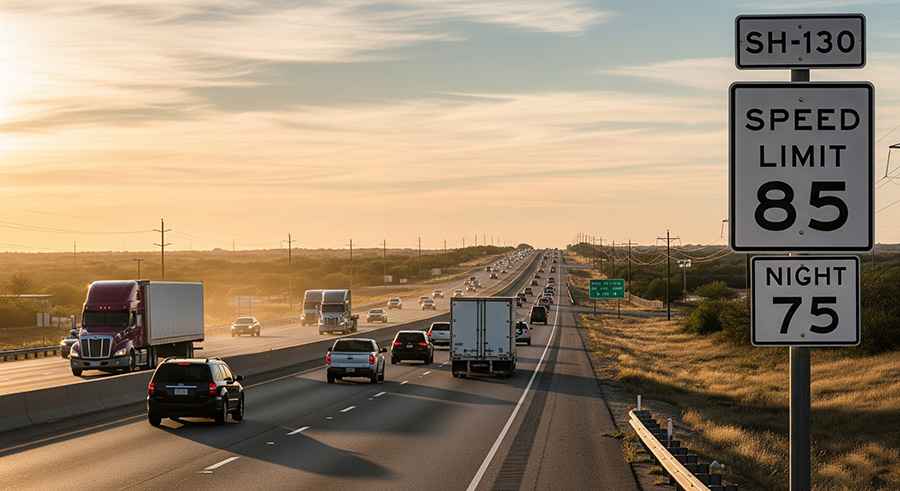Texas 85 mph Speed Limit: The Dangers and Benefits
Texas has its share of dangerous roads, from crowded interstates to rural highways where serious crashes happen far too often. At the same time, it holds the fastest legal speed in the nation with an 85 mph limit on a 40-mile stretch of SH-130 between Austin and San Antonio. Questions around the Texas 85 mph speed limit center on where it applies, why the state set it there, and what that pace means for safety, time savings, fuel use, and costs.

Tradeoffs stand out. SH-130 pulls drivers off I-35 and trims travel time for commuters and freight, while higher speeds expand stopping distances, intensify crash forces, and narrow the margin for error. A clear view of the issue ties tangible gains to real costs across safety, fuel consumption, insurance, and public services.
The Case for 85 mph
Efficiency and Traffic Flow
SH-130 was engineered with high speeds in mind. Long straightaways, broad lanes, and limited entry points give it capacity for faster travel than most Texas highways. Commuters and freight operators save meaningful time compared with crawling through I-35, which is among the country’s busiest corridors.
Economic and Regional Impact
Traffic that shifts from I-35 to SH-130 eases one of the state’s most persistent bottlenecks. The toll road also supports regional commerce by cutting travel times for trucking companies and delivery services moving freight through central Texas. Those minutes add up across thousands of trips each week.
Driver Autonomy and Culture
The 85 mph posting reflects Texas’ long-standing affinity for open-road driving. Many motorists were already traveling near that pace, so the law aligned the posted limit with how the road was being used in practice. It reinforced the perception that drivers, not just regulators, shape highway behavior.
The Concerns About 85 mph in Texas
Safety and Crash Severity
At 85 mph, the physics of a collision change quickly. The force of impact rises with every mile per hour, and survival rates drop. Drivers also have less time to react, so a brief distraction or a misjudged lane change can carry serious consequences.
Fuel Use and Emissions
Gas mileage falls once speeds climb past 70 mph, and by 85 the drop is steep. Cars and trucks burn more fuel to hold that pace, which adds cost for drivers and pushes out more exhaust. That level of fuel use also runs against efforts to cut emissions statewide.
Health and Insurance Costs
When a crash happens at higher speeds, emergency crews face tougher situations and trauma centers see more severe injuries. Those outcomes translate into higher costs that don’t just hit families but also show up in insurance data, where states with higher limits face more expensive claims and steeper premiums.
Enforcement and Driver Behavior
Law enforcement presence on SH-130 is inconsistent. Drivers report stretches of the toll road with little patrol activity followed by targeted crackdowns. When tickets are issued, they are often written for speeds well over the 85 mph posting, which shows that the upper limit is not always treated as a hard ceiling.
That uneven enforcement shapes how the road is used. Some drivers treat SH-130 as a chance to run well above the sign, while others hold back out of concern for the cost of a citation. The result is a wider gap in speeds than you see on many Texas highways, and that gap can create its own safety problems.
Balancing Factors
Road Design vs. Human Behavior
SH-130 was laid out for high speeds with wide shoulders and long sightlines. That doesn’t change the fact that drivers bring different levels of focus, experience, and patience. The road may be ready for 85, but the human element is always the variable.
Comparisons with Other States
Utah and parts of Wyoming post 80 mph, and that’s where they stop. Texas went further. SH-130 ends up as a one-off experiment, with the rest of the country watching how it plays out.
Policy Tradeoffs
Time savings and economic gain sit on one side of the scale. On the other side are tougher crashes, higher insurance payouts, and more fuel burned. Texas’ decision puts that tradeoff out in the open: how much risk the state is willing to carry in exchange for speed.
Balancing the Gains and the Risks
Texas went further than anyone else with the 85 mph limit on SH-130, and the road still stands as the only place in the country where drivers can legally move that fast. For some, the extra minutes saved feel worth it. For others, the higher crash forces, extra fuel, and bigger bills make it a gamble they wouldn’t take.
The sign hasn’t changed since it went up, and neither has the divide over whether it should have been raised that high in the first place. SH-130 keeps carrying cars and trucks every day, and it keeps carrying the debate right along with them.